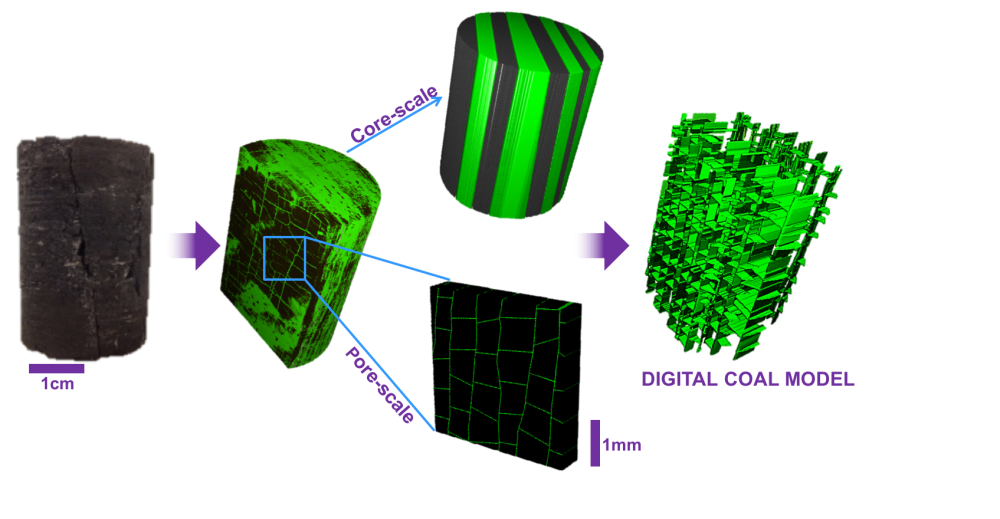Ryan Armstrong’s expertise lies in ‘Digital Rock’. No, this has nothing to do with music, and everything to do with unlocking the secrets of that mysterious solid aggregate of minerals that holds so much of our planet together.
“I take X-ray micro computed-tomography images of rocks, particularly those relevant to the oil and gas industry,” says Dr Ryan Armstrong, Senior Lecturer in UNSW’s Petroleum Engineering. “Then we use the images to predict the rock’s effective properties, so how easily water, oil or sometimes gases flow through it.”
Armstrong says Digital Rock technology is a fast, efficient and accurate way to predict rock properties, and has become a vital tool for oil and gas companies involved in reservoir simulation and management. “The process was much more cumbersome in the past,” he says. “Companies would have to take a rock core sample from the reservoir, hook it up inside a flow cell in a lab and pump water and gas into it to see how easily they passed through. It might have taken two weeks to get a single result, but with Digital Rock we can do it in an afternoon. It’s revolutionised the process.”
Having done his PhD at Oregon State University on X-ray microtomography imaging, Armstrong embarked on his postdoc at the Shell Technology Centre in Amsterdam where he and his colleagues honed their digital tools to evaluate rock properties for reservoir scale models. About three years ago he joined UNSW to continue in his theme and in 2015, along with his colleague Dr Peyman Mostaghimi set up the Multiscale Transport in Porous Systems (MUTRIS) research group. Most recently, they’ve been promoting their COALSIM Technology, a new method to accurately calculate the petrophysical properties of coal. In particular, the team is able to predict gas production from coal seam gas reservoirs with significantly greater accuracy, thus improving gas yield.”
Armstrong says that although the capabilities of micro-CT imaging and the resolutions required to push this technology forward have been around for about 20 years, it wasn’t until three or four years ago that computational processing came up to speed. Literally. “During my PhD, some of the numerical simulations took up to a month. Now graphical processing units (GPU) are able to do these computations in a matter of hours. That was the breakthrough we needed to make this a practical tool. I’m lucky to have access to the supercomputer Raijin in Canberra (part of the Australian Government National Computational Infrastructure), but I also have connections at Virginia Tech and the Oak Ridge National Laboratory where they run Titan, one of the largest supercomputers in the United States.
It might have taken two weeks to get a single result, but with Digital Rock we can do it in an afternoon. It’s revolutionised the process.
Ryan Armstrong, Senior Lecturer, UNSW Petroleum Engineering
Petroleum engineers, says Armstrong, are always dealing with a very sparse data set so any intel they can gather is crucial. “Even at the most mature reservoirs in the world, we have only retrieved about 40% of the available oil, so there is a lot left to learn about recovery. One way, for example, might be to inject different surfactants and chemicals to help mobilise the oil, and this is precisely what we can analyse with Digital Rock. We can test lots of different variables and possibilities, and use data analytics to explore what the best reservoir management scheme might be.”
Although applications are mostly aimed at the oil and gas industry, Armstrong says the technology is very broad and can be applied to any type of porous media. “The simulation and modelling techniques we’re applying can be transferred to a wide variety of areas including understanding hydrogen fuel cells, and understanding carbon sequestration (where carbon dioxide is injected into the subsurface for storage over geological time). It might also have applications in membrane science technologies and groundwater hydrology as well,” Armstrong continues.
As for the future, he is very excited about advances in artificial intelligence and machine learning and how he might integrate this into his research. “Energy is a great research area to be in because it is fundamental to our quality of life,” he says. “It is also one of the most relevant as we ask ourselves, ‘How are we going to sustain our quality of life, continue GDP growth, and produce the energy requirements necessary to move forwards?’ I think of natural gas as an important transition fuel as we move towards renewable energies, a really pragmatic way to bridge the gap.”
If you would like to find out more about Digital Rock and how it might be applied to your business, please contact Ryan Armstrong: ryan.armstrong@unsw.edu.au
Written by: Penny Jones
